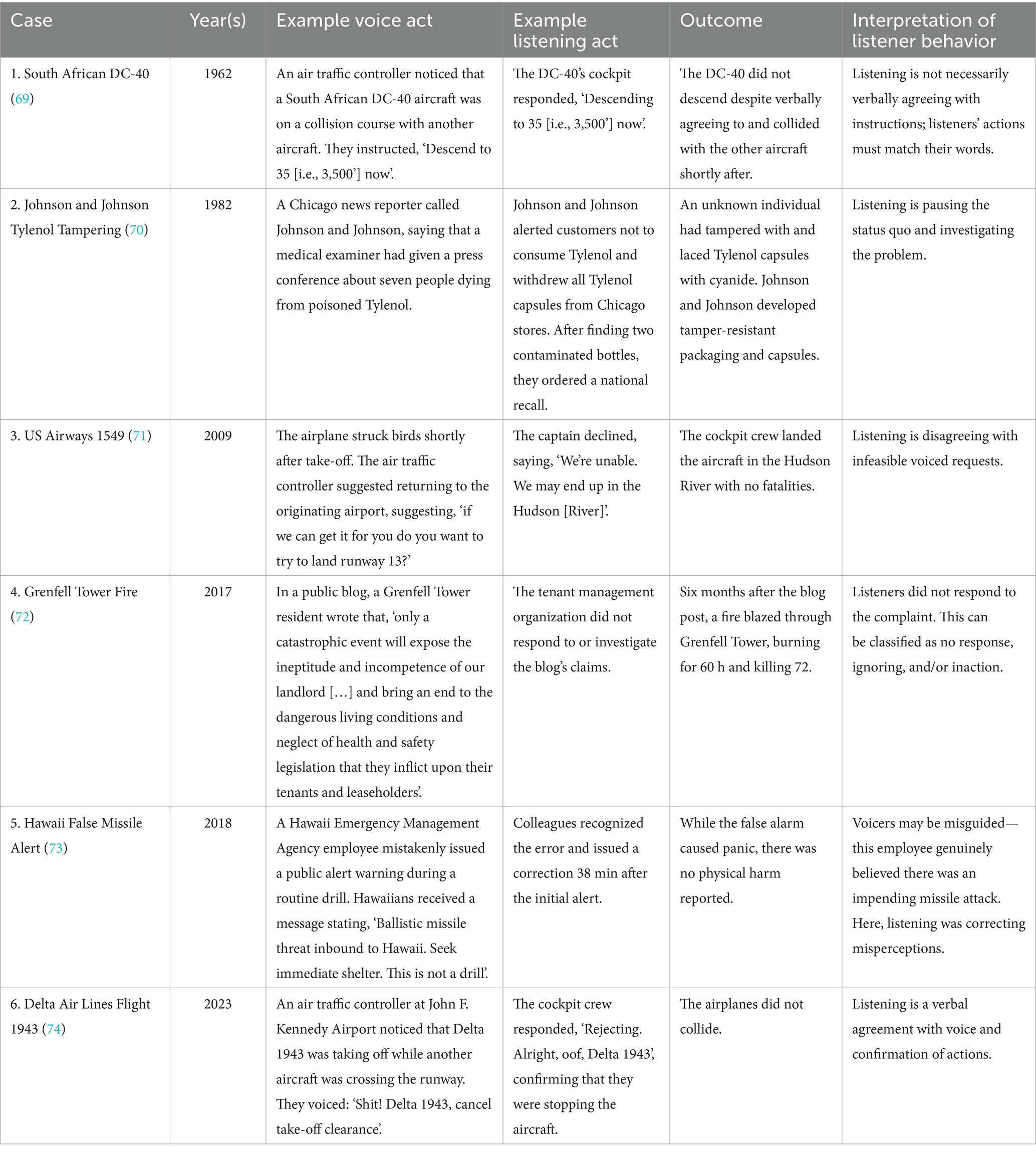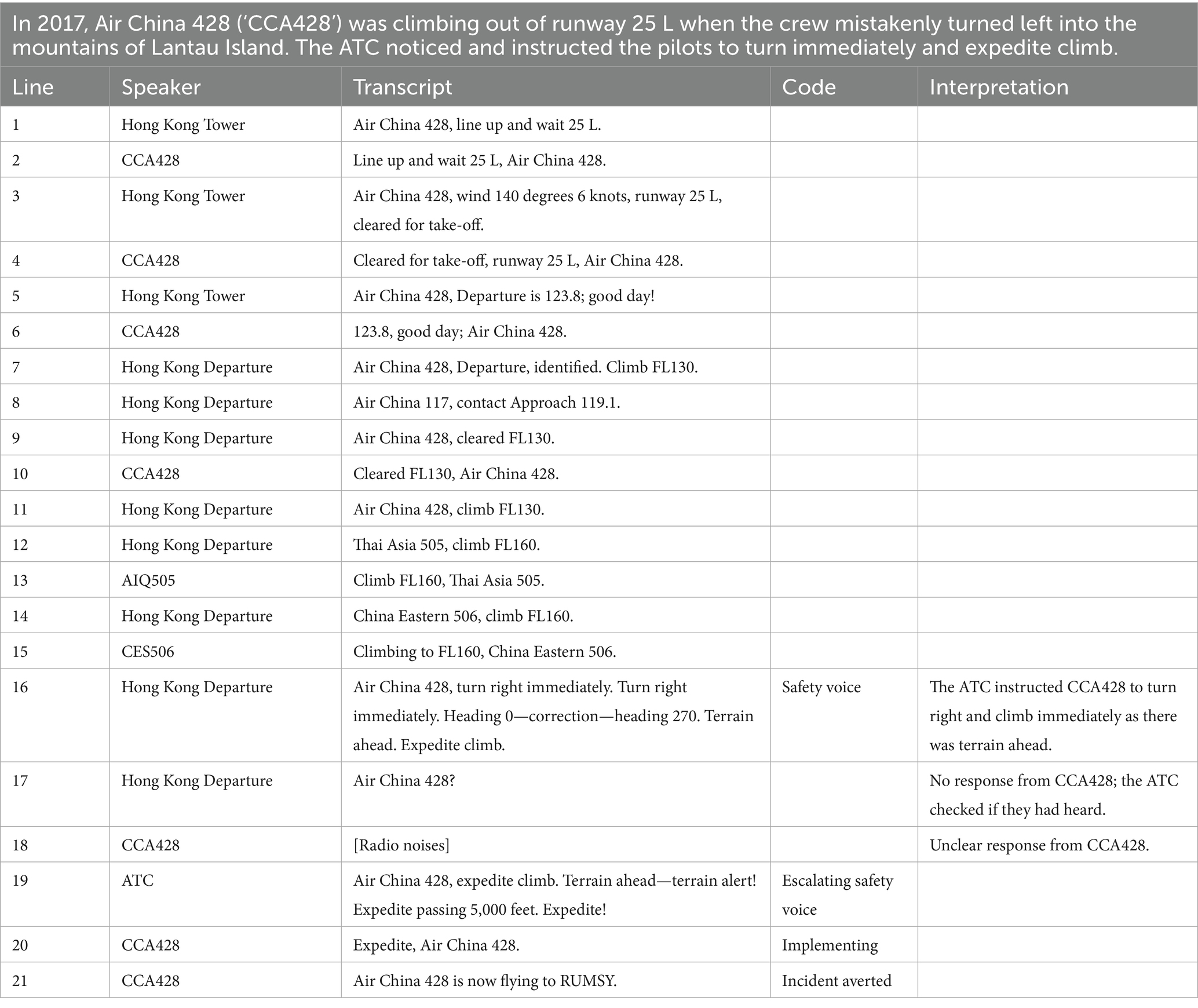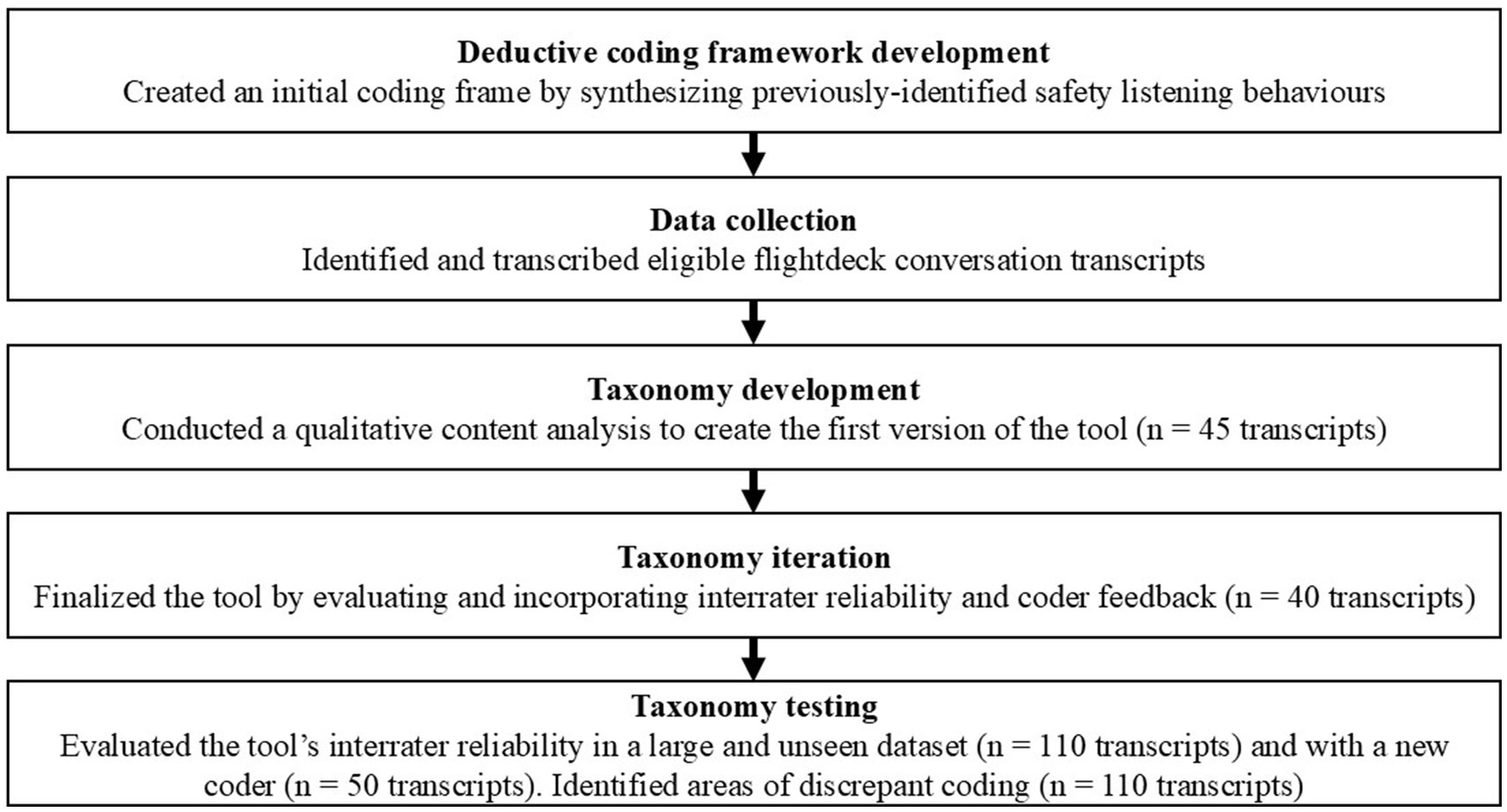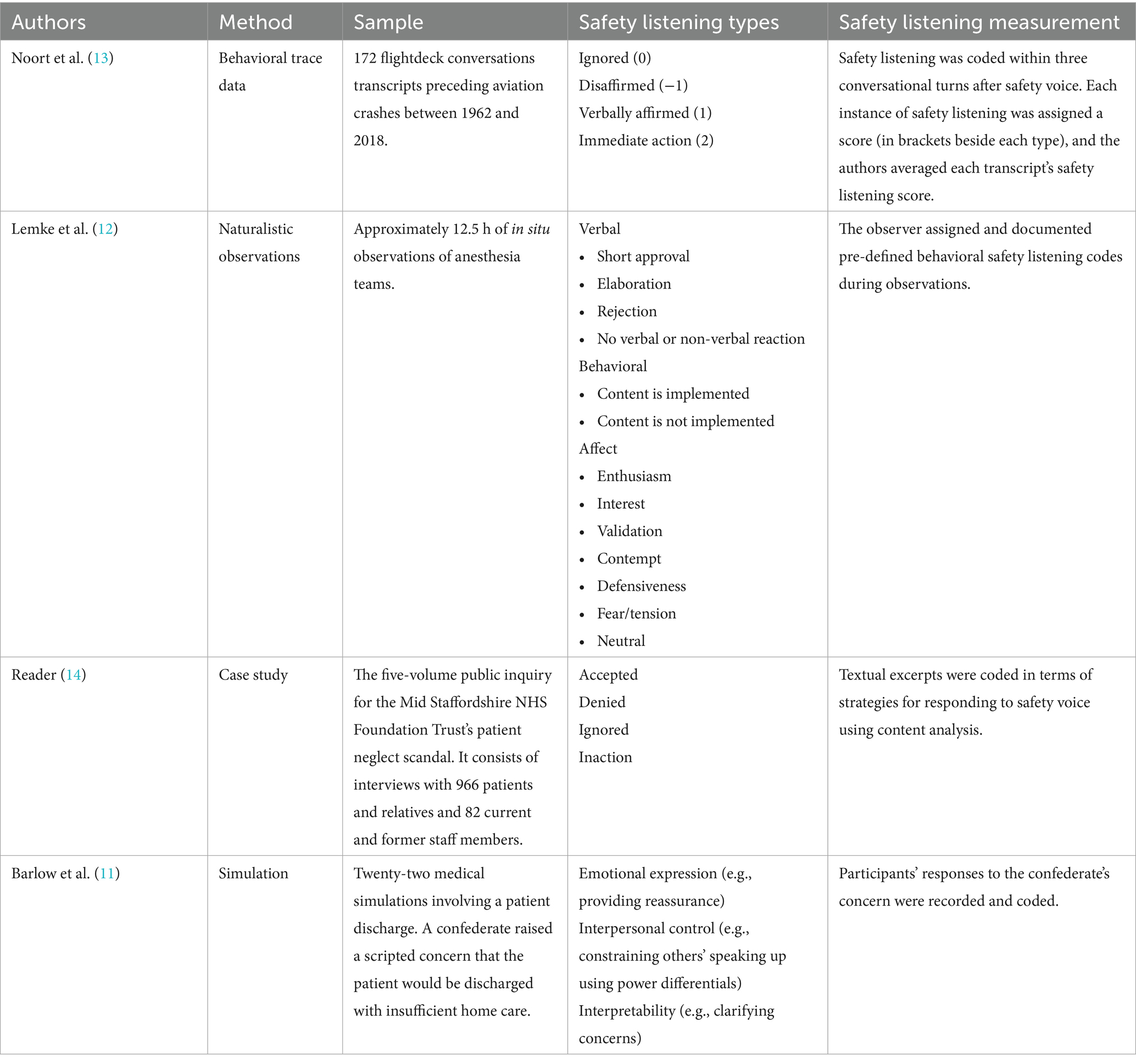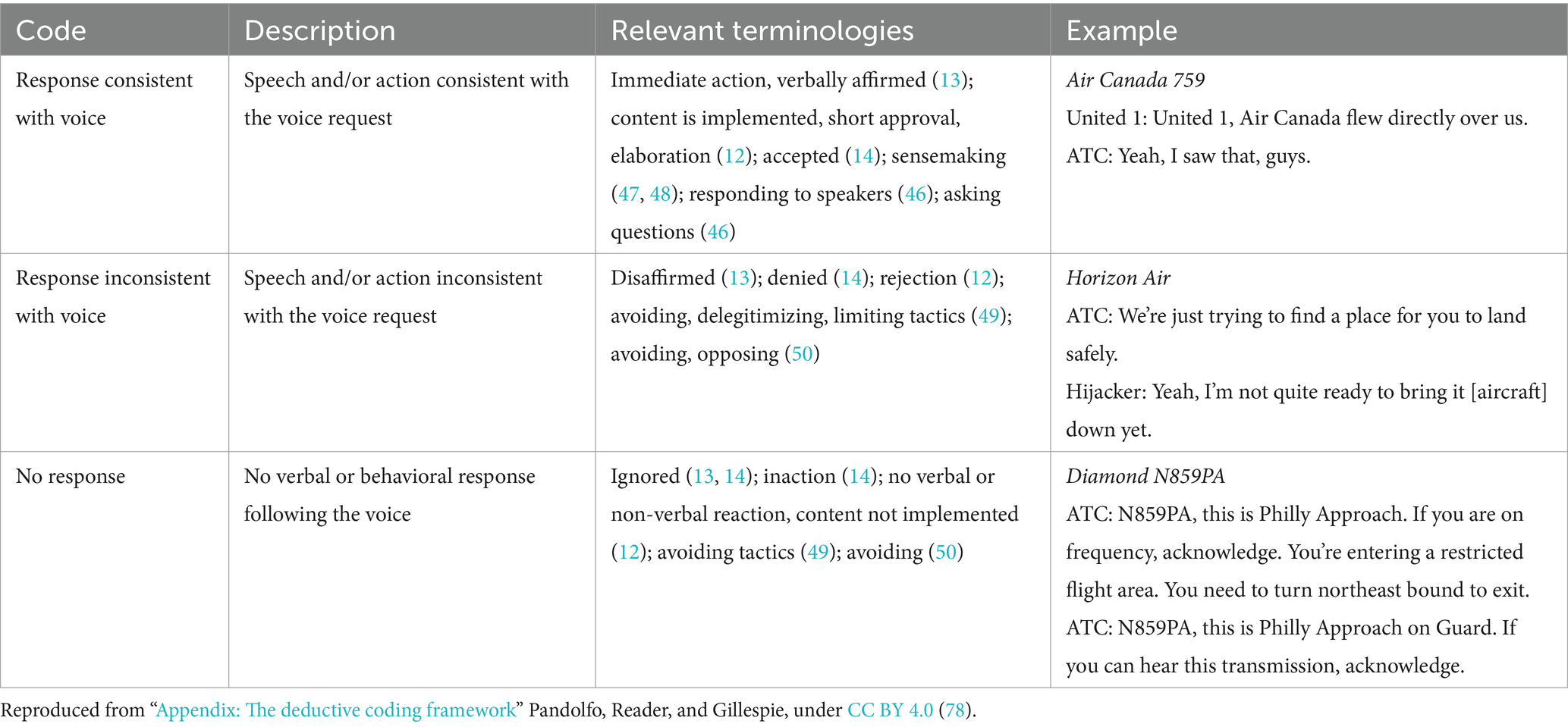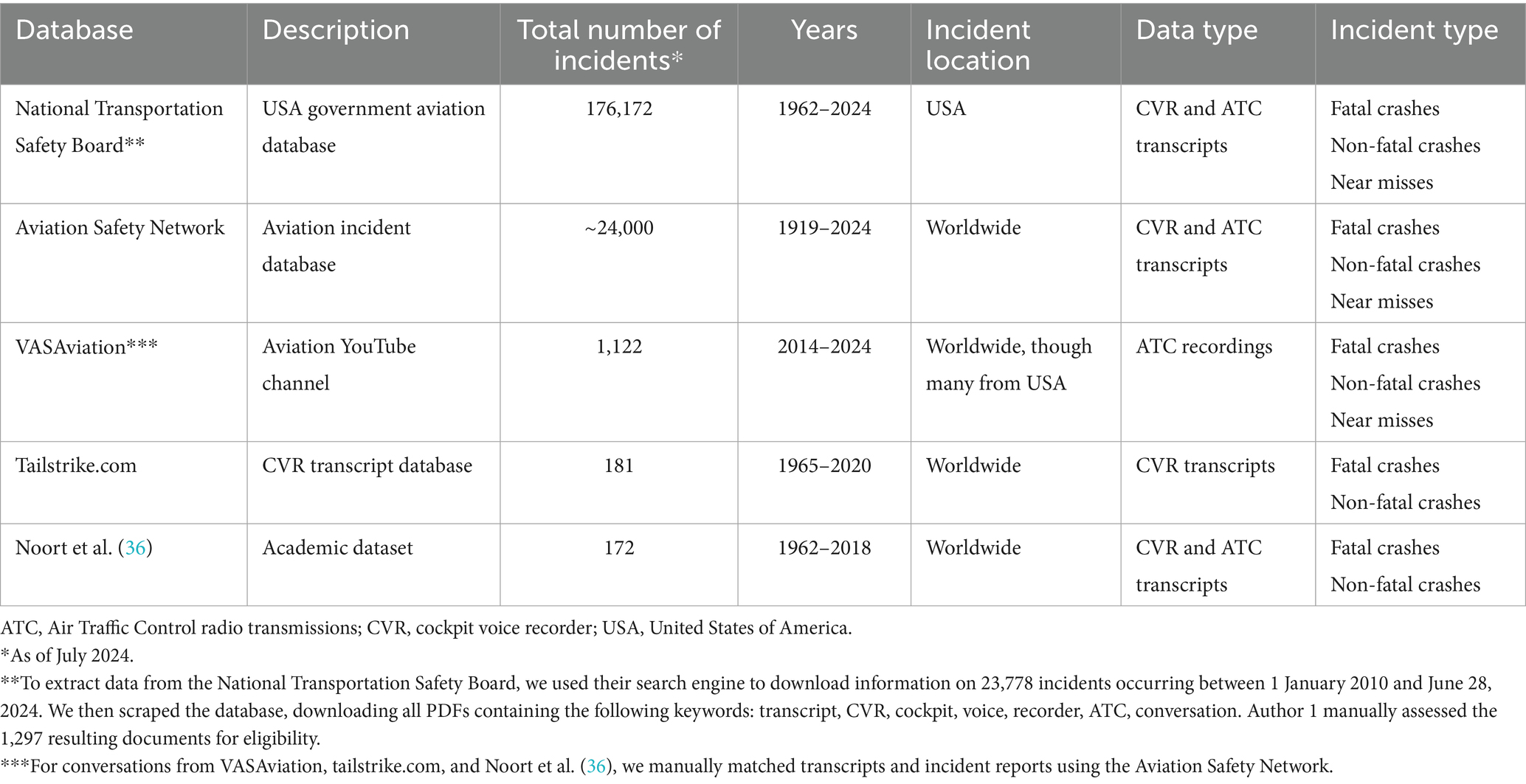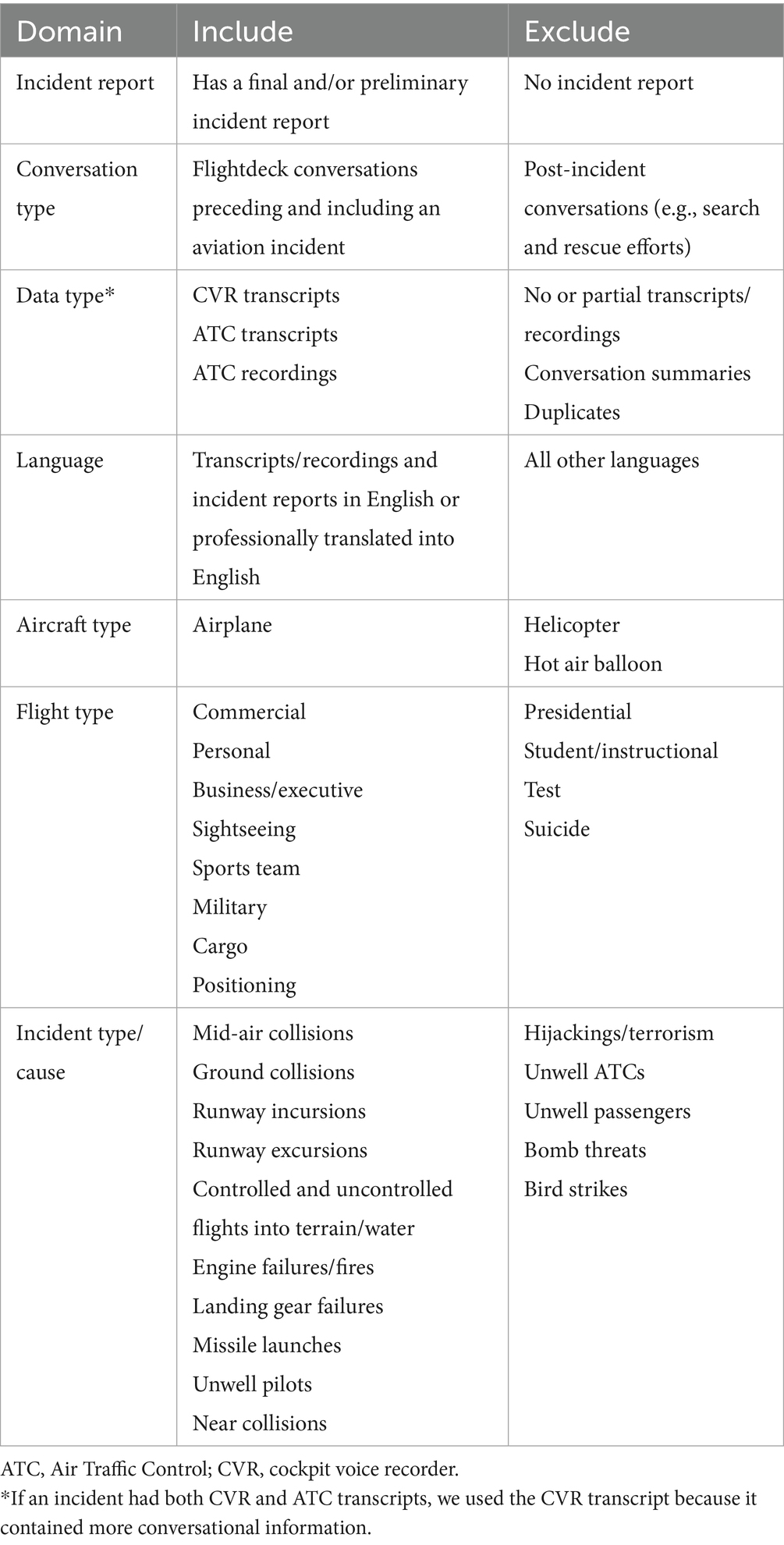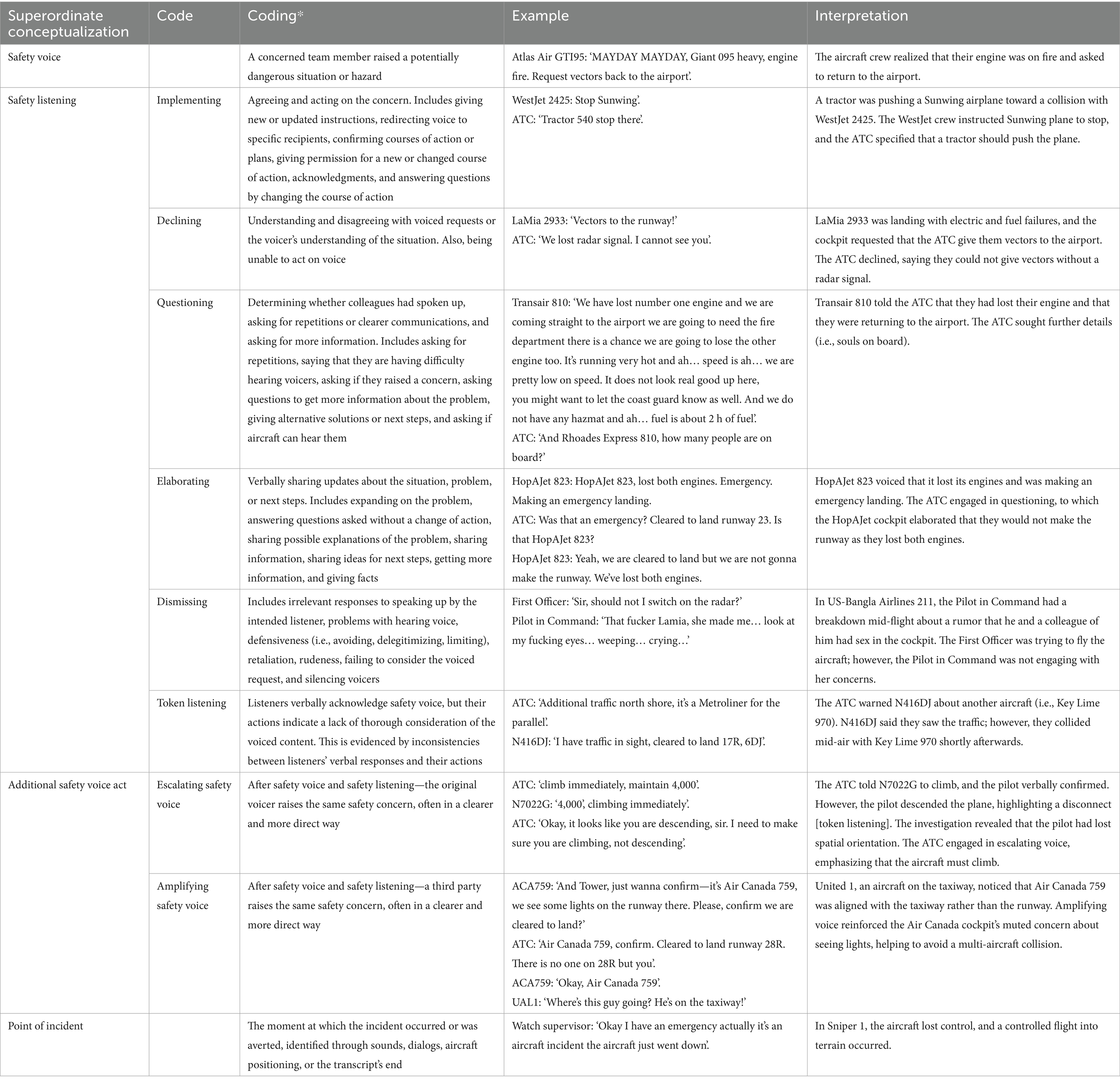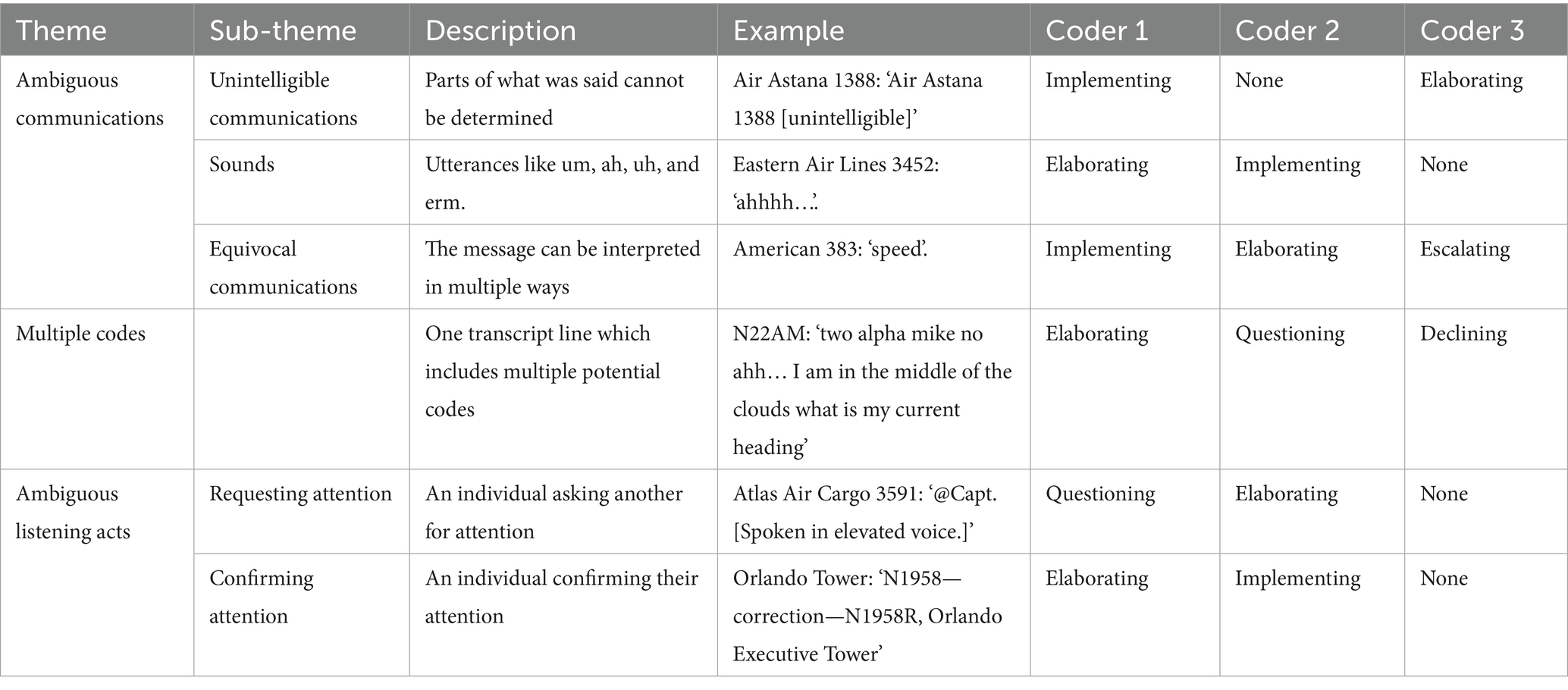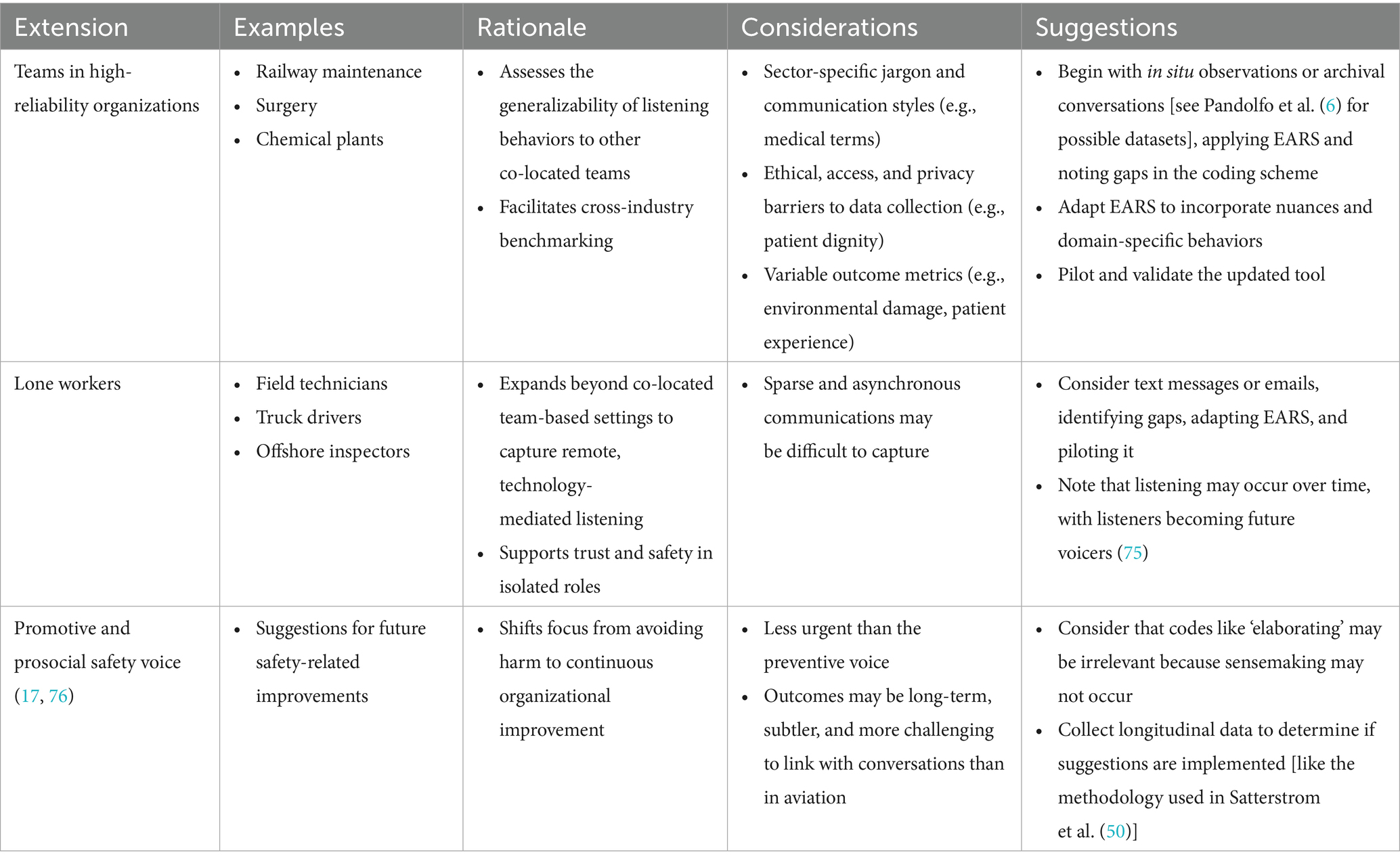- 1Department of Psychological and Behavioural Science, London School of Economics and Political Science, London, United Kingdom
- 2Oslo New University College, Oslo, Norway
Introduction: Safety communication is crucial for accident aversion across industries. While researchers often focus on encouraging concern-raising (‘safety voice’), responses to these concerns (‘safety listening’) remain underexplored. Existing studies primarily use self-report measures; however, these tend to focus on perceptions of listening rather than behaviors. To fully understand and examine how safety listening is enacted and influential in safety-critical environments, a tool for reliably assessing naturalistic safety listening behaviors in high-risk settings is required. Accordingly, we developed and tested the Ecological Assessment of Responses to Speaking-up (EARS) tool to code safety listening behaviors in flightdeck conversations.
Methods: There were three analysis phases: (1) developing the taxonomy through a qualitative content analysis (n = 45 transcripts); (2) evaluating interrater reliability and coder feedback (n = 40 transcripts); and (3) testing the taxonomy’s interrater reliability in a larger unseen dataset (n = 110 transcripts) and with an additional coder (n = 50 transcripts).
Results: Contrary to the notion that effective listening is agreement, our findings emphasize engagement with safety voice, including reasonable disagreement. The final taxonomy identifies six safety listening behaviors: action (implementing, declining), sensemaking (questioning, elaborating), and non-engagement (dismissing, token listening) and two additional voice acts (escalating, amplifying). EARS achieved substantial interrater reliability (Krippendorff’s alpha of 0.73 to 0.77 and Gwet’s ACT1 of 0.80 to 0.87).
Discussion: The EARS tool allows researchers to assess safety listening in naturalistic conversations, facilitating analysis of its antecedents, its interplay with safety voice, and the impact of interventions on outcomes.
1 Introduction
Effectively raising and responding to safety concerns is critical for averting organizational failures. Accidents like the Challenger and Columbia space shuttle disasters, the Boeing 737 MAX crashes, and the Deepwater Horizon catastrophe have all highlighted how problems in speaking up and responding effectively to voice have contributed to incidents (1–3). Consequently, safety researchers have extensively focused on how organizations can encourage individuals to speak up with safety concerns (‘safety voice’), establishing team- and institutional-level voice antecedents and integrating effective safety voice behaviors into behavioral marker systems (4, 5). Yet, while safety voice is often crucial for maintaining safety and preventing accidents, it cannot achieve this without ‘safety listening’, which relates to how listeners engage with the content of safety voice (6). As illustrated in Table 1, safety listening is an important factor in both causing and preventing accidents. In these instances, individuals raised concerns about safety problems, and the response of individuals or organizations to these concerns (e.g., engaging with or dismissing issues) determined the outcomes.
Despite the apparent importance of safety listening for preventing accidents and improving safety, the literature lacks an established method for assessing listening behaviors. Safety listening measures are typically self-reports, such as surveys and interviews (7–9). While self-report measures these provide insights into experiences or perceptions of listening within organizations, they do not support the evaluation and improvement of safety listening. Behavioral marker systems research has shown how structured and theory-based assessments of live behavior in safety–critical environments are essential for documenting different forms of behavior that link to outcomes, supporting training, evaluating interventions, and changing organizational culture (4). For example, behavioral marker systems have been extensively used to improve teamwork and decision-making in healthcare (10). Hitherto, when safety listening has been studied naturalistically or through observational frameworks, researchers have variously conceptualized and operationalized the categories of behavior that comprise listening (11–14).
To understand how exactly safety listening shapes outcomes in dynamic and high-risk contexts, and investigate the effectiveness of listening behavior in teams, a reliable method of assessing safety listening behaviors in naturalistic high-stakes conversations is needed. This method would enable safety researchers to analyze live behavior and novel behavioral datasets, improve findings’ comparability, support assessment and training, and evaluate listening before and after interventions. Here, we develop and test the Ecological Assessment of Responses to Speaking-up (‘EARS’) tool and test its reliability by using it to classify instances of safety listening in transcripts of flight crews interacting during safety incidents.
1.1 Background
Communication about hazards is a necessary precursor to promoting safety and averting organizational failures. For example, Westrum’s (15) theory of information flow argues that communication on risks, events, and anomalies is essential for ensuring that hazards are understood and effectively managed. Conversely, communication breakdowns (e.g., due to silos, scapegoating of those who share negative information) impair safety management (15). As safety communication is ultimately anchored in individuals sharing information, researchers have extensively investigated behaviors underlying safety voice (raising concerns about safety hazards), exploring how speaking-up can be encouraged in organizations (5, 16). Through this work, researchers have established a conceptualization of safety voice (17), with speaking-up viewed as a spectrum between direct communication and silence (18), and constructs like ‘muted voice’ capturing indirect forms of safety voice where individuals hint at rather than push concerns (19). Academics and practitioners have typically assessed safety voice using self-report measures (5); however, more recent studies have identified observable voice behaviors (e.g., expressing concerns) and have measured them in naturalistic settings (12, 13).
In contrast to the literature’s focus on safety voice, fewer studies have explored its counterpart: safety listening. Academics have variously conceptualized safety listening within and between literatures, with a recent conceptual review finding 36 unique terms/definitions (6). While some neutral terminologies were used [e.g., ‘receiver response’; (8)], most depicted consequences of voicing [e.g., ‘retaliation’; (20)]. Likewise, listening was framed as motivational via terms like ‘willful blindness’ (21) and the ‘deaf ear syndrome’ (22) and responses were explained as strategic maneuvers within games [e.g., ‘blame games’ and ‘organizational jiu-jitsu’; (23, 24)]. In sum, the literature has generally viewed safety listening as listeners’ attitudes following voice, with poor responses positioned as motivational and deliberate.
Synthesizing the literature’s conceptualizations, Pandolfo et al. (6) conclude that safety listening is more usefully defined as a listeners’ responses to speaking up, requesting action to prevent harm. This definition positions safety listening as behavioral rather than attitudinal: it is how listeners act to understand or address potential hazards, with attitude being among various factors (e.g., training, knowledge and skills, clarity of voice act) that shape whether and how listeners respond to voice effectively. Listening is conceptualized in terms of the distinct patterns of behavior—for instance, approving, ignoring, replying, retaliating—that occur after speaking-up (25). Accordingly, the effectiveness of safety listening is determined by whether the response engages with the voice act. Consequently, discounting safety voice may be effective if it is suitable (e.g., voicers raised incorrect information), respectful, does not hinder future voice acts, and does not cause harm. As illustrated in Table 1, adopting a behavioral approach to safety listening is important because how listeners respond to voice can vary according to the situation being faced, and with responses enabling the individual and collective sensemaking required to address problems and prevent harm (26). Where listening behaviors are ineffective—for instance, dismissing legitimate concerns and/or acting on safety voice, which is well-motivated but incorrect—understanding and decision-making on risk is impaired. Hitherto, despite the importance of safety listening in averting accidents, there is currently no established method of reliably assessing safety listening in high-risk settings.
1.2 The need for a safety listening behavior assessment
As discussed above, research in the domain of safety has rarely taken a behavioral approach to investigate safety listening, despite listeners’ behaviors being self-evidently crucial for preventing accidents. Where research has been done, it has generally used surveys and interviews, rather than ‘live’ investigations of natural behavior (6). Using proxies of behavior resonates with more general critiques of psychological research, where there has been a push for psychologists to measure naturalistic behavior to ensure that observations are grounded in real and consequential activity (27, 28).
Developing a method for assessing safety listening in natural and safety–critical settings would advance theory and practice. Pandolfo et al. (6), conceptual review found that two out of 46 empirical safety listening studies assessed naturalistic behaviors; the remainder employed self-report methods or assessed hypothetical behaviors, with these being used as proxies for naturalistic behavior. While valuable for understanding safety listening, such proxies can have critical limitations—most importantly, it cannot be assumed that findings in safe and created settings generalize to uncertain environments with potential harms, or will effectively predict and explain how individuals will respond to safety voice in complex and uncertain situations (29). Self-reported listening intentions and behaviors may be inaccurately described, recalled, and attributed due to biases (e.g., social desirability), errors (e.g., memory errors), and misinterpretations (30, 31). Researchers also have studied generalized responses (e.g., whether individuals feel listened to on average) rather than the actual moments of listening that have direct consequences for outcomes (e.g., engaging with concerns). Hypothetical vignettes may over-rely on participants’ imaginations, while experiments require participants’ belief in confederates’ roles and instructions (32). Moreover, assessing voicers’ and listeners’ perceptions of listening may not correlate with behavioral listening assessments, as Bodie et al. (33) found no association between these three measures. Likewise, Collins (34) argues that verbal markers (e.g., paraphrasing, follow-up questions) are the best listening indicators because they cannot be faked.
Another limitation of the safety listening literature’s focus on behavioral proxies is its tendency to frame safety communications as one-off exchanges (i.e., one voice act, one listening act, and then outcome) in clear-cut situations with defined speaker roles and actionable concerns (6). For instance, Long et al. (8) posit that after safety voice, listeners determine and enact their response, and their response has implications for patient care and team dynamics. Yet, naturalistic safety conversations are not always one-shot and unambiguous. For example, as the events of September 11, 2001 (coordinated terrorist hijackings targeting the World Trade Center and the Pentagon) were unfolding, Northeast Air Defense Sector members were initially misguided, incorrectly believing they were in a training simulation (35). Some members voiced doubt (‘Is this real-world or exercise?’), prompting further discussions, which improved the team’s understanding of the situation. Namely, the team first updated their belief to be that the hijacks were real but prototypical (‘[the situation] will simmer down and we’ll probably get some better information [i.e., hijackers will make demands]’) and then ultimately reached the correct conclusion that this was a coordinated attack (‘if this stuff [i.e., multiple hijacks/attacks] is gonna keep on going, we need to take those fighters [fighter jets], put ‘em over Manhattan’). Consequently, safety conversations may be an iterative process characterized by sensemaking, blurred delineations between voicers’ and listeners’ roles, and misguided interpretations of situations (6, 26).
Researchers’ use of self-report measures and experiments to study safety listening is understandable due to challenges with accessing—particularly in a controlled and rigorous manner—real-life situations where listening is critical for accident prevention. Recent advances in technology and the availability of digital data have made it increasingly possible to study safety listening through observational and/or behavioral trace data, enabling theory and empirical observations to be anchored in ecologically valid and contextualized situations [i.e., those that contain real safety threats; (36)]. While researchers always could study safety listening behaviors in situ [‘naturalistic observation’; (e.g., 12)], they can now use new technologies like body cameras [‘ecological observation’; (37)] or behavioral trace data—transcripts or recordings of actual conversations containing safety voice and listening. Pandolfo et al. (6) give examples of unobtrusive and public datasets, including healthcare complaints and space mission communications.
To capitalize on these new opportunities and datasets, a framework of observable safety listening behaviors is required. Research on assessing and improving non-technical skills in safety–critical domains has long emphasized that, to reliably and meaningfully assess behavior, researchers must develop theoretically coherent taxonomies of observable behaviors that either enhance or impede safety performance (4). Studying safety listening through observations, therefore, is necessary to develop a framework of the core behaviors through which individuals respond to safety voice, establish the reliability of this framework, and then explore the link to outcomes. Such behaviors—according to the literature—may include various and quite basic categories like addressing problems, elaborating, agreeing with concerns, ignoring complaints, disagreeing with concerns, rejecting, or denigrating the voicer (12–14, 38). Furthermore, the impact of such behaviors upon safety outcomes is not necessarily straightforward and is challenging to evaluate outside of the context of the situation in which they occur. For instance, while the listening literature generally views disagreeing with voice as indicative of poor listening [and measures listening through whether voicers feel heard; (39)], effective safety listening can involve not acting on a voice (because it is misguided), interpreting a voice act as a signal of a more profound misunderstanding (e.g., on the goal of a team), or questioning the voicer to fully understand a problem (6).
In sum, there is minimal standardization of how to code naturalistic safety listening or to understand how these behaviors contribute to safety outcomes. Generating a standardized, reliable, and accurate classification system would have multiple benefits for the literature: it would enable the reliable coding of safety listening in naturalistic data (6), improve the conceptualization of safety listening and its impact on safety outcomes through anchoring it in contextualized behaviors (i.e., responses to voice acts) rather than general attitudes (40), and support practical efforts to assess and improve listening behaviors in organizations through evaluating how individuals respond to safety voice acts and findings’ comparability (4).
1.3 Current study
To address the above research gap, the current study reports on the development of the EARS tool for measuring safety listening through analyzing conversational dialog. The tool’s function is to support the reliable observation of safety listening in both live settings and transcript data. To build the tool, we focused on one of the most consequential and curatable data sources for studying safety listening: flightdeck conversations (36).
1.3.1 Flightdeck conversations
Flightdeck conversations involve exchanges within teams regarding take-off and landing authorizations, weather updates (e.g., wind speeds), and issue reporting (e.g., flap problems). English is the standard language (77); however, local languages may be used in non-essential communications within cockpit teams.
Flightdeck conversations are generally accessed through cockpit voice recorders (CVRs) and/or air traffic control (ATC) radio recordings that document flightdeck interactions. CVRs capture all sounds—including alarms—and conversations within the cockpit, involving captains, first officers, and ATC. Conversely, ATC recordings capture communications and noises broadcast over specific radio channels but do not include intra-cockpit conversations. Globally, airports record ATC communications for purposes like accident analysis and training, and anyone within 15 miles/24 km of airports can also record these conversations (41).
These recordings are predominantly available through two sources. First, government agencies transcribe and publish CVR and ATC recordings in detailed incident reports. These reports are thorough and independently conducted, combining multiple sources of evidence to understand and learn from incidents. Second, volunteers often upload ATC recordings to platforms like YouTube to be used for educational purposes (e.g., assisting student pilots in learning aviation terminology). Table 2 shows a sample transcript.
We used CVR and ATC recordings to develop the EARS tool for the following reasons. First, researchers have encouraged the aviation industry to consider and train interpersonal skills within sociotechnical systems to enhance safety (42). Psychological safety, safety voice, and safety listening have been identified as crucial behaviors underpinning aviation safety, which sometimes require improvement (13, 43). For instance, out of 172 transcripts preceding aviation accidents, Noort et al. (13) identified 82 incidents which exclusively had effective listening and 33 that contained repeated poor listening. Thus, this dataset contains variability in safety listening types.
Second, flightdeck conversations are world-making (44). These recordings unobtrusively capture actual safety communication in risky situations, depicting how safety voice and listening behaviors cause or avert accidents. Aviation’s standardization (e.g., linguistic patterns, training, encountered risks) provides a controlled and ecologically valid setting to examine safety communication behaviors. Using this dataset follows recommendations to balance behavioral and self-report assessments in psychology (28) and avoids self-reports’ limitations (e.g., memory errors and attribution biases). In this study, we analyze flightdeck conversations before safety incidents, as these situations are where safety listening is most likely to be observable and consequential.
Third, aviation crew members understand that their conversations are recorded via CVRs, airport operational monitoring systems, and by individuals interested in aviation. Governmental agencies and aviation enthusiasts have made flightdeck conversations publicly available with the intent of explaining incidents and improving aviation safety; our use aligns with this intended purpose.
1.3.2 Study aims
Using flightdeck conversations as our data source, we aimed to (1) develop and test the EARS tool and (2) explore its reliability in classifying safety listening and potential for informing organizational learning. We did this in three phases.
First, in taxonomy development, we used directed and summative content analysis to create the first version of EARS. This phase involved deductively applying a coding framework derived from the literature to 45 transcripts, inductively grouping similar behaviors and identifying listening forms not covered by the literature, and abductively exploring tensions between the literature and the transcripts.
Second, in taxonomy iteration, four coders applied the initial version of EARS to the same 10 transcripts. Interrater reliability and coder feedback were used to develop the next iteration of EARS, which was subsequently applied to a new batch of 10 transcripts. This process was repeated until we deemed saturation; this occurred after four rounds of iteration.
Third, in taxonomy testing, three coders coded 110 transcripts with the final version of EARS. A fourth coder, previously uninvolved with this study, coded 50 of the same transcripts using the final version. EARS obtained substantial interrater reliability in both analyses, and we investigated instances of coder disagreement.
When creating EARS, we drew upon the non-technical skills and behavioral marker systems literature. This literature posits that, in addition to developing technical skills (e.g., flight skills), assessing and training non-technical skills like teamwork, leadership, situation awareness, and decision-making is essential for safe and effective work performance (4). As previously discussed, behavioral marker systems—observational tools that taxonomize and assess non-technical skills—are widely used to identify and improve such behaviors in organizations (e.g., in surgery and aviation). Hitherto, while studies of non-technical skills often show communication as essential for success (e.g., in aviation), behavioral marker systems usually focus on behaviors like transmitting plans or delegating tasks rather than on listening behaviors (45).
Our study contributes to the literature by creating a behavioral marker system for safety listening: the EARS tool. This tool taxonomizes safety listening’s observable behaviors, and we test its reliability using flightdeck conversation transcripts. The EARS tool will enable research, contribute to theory development on voice and listening, and support practical interventions and efforts at organizational learning (e.g., in assessing the state and quality of safety listening within organizations). The tool aims to shift how we understand safety listening: moving it to a behavioral perspective that focuses more on whether listening happens (and its impact on safety) rather than attitudes and beliefs around listening which may or may not accurately reflect what occurs in specific and high-consequence safety situations.
2 Methods and results
We developed, iterated, and tested the EARS coding framework of safety listening behaviors, assessing listening at the turn level. All authors are research psychologists with experience analyzing flightdeck conversations and mixed-methods research. Authors 2 and 3 have developed and validated multiple psychological assessments. Figure 1 shows a process diagram summarizing the tool creation steps.
2.1 Deductive coding framework development
We first created an initial coding framework of safety listening types, informed by the literature. We searched for articles that identified and/or assessed different types of listening behavior. Specifically, we examined the 57 articles included in Pandolfo et al. (6) safety listening conceptual review, the 53 listening scales in Fontana et al.’s (46) systematic review, and relevant classifications from other literature, including sensemaking (47, 48), defensiveness (49) and voice cultivation (50).
Four articles classified and/or assessed safety listening behaviors, summarized in Table 3. Using abduction, we grouped similar behaviors, finding that safety listening responses were consistent with the voice request, inconsistent with the voice request, or did not respond to the voice. Table 4 shows our initial deductive coding frame, which we applied to the data and refined in the taxonomy development stage.
2.2 Data collection
Our data were flightdeck conversations preceding near misses and crashes (collectively referred to as ‘incidents’). We obtained actual flightdeck conversation transcripts and recordings from five public data sources, summarized in Table 5. Author 1 reviewed the datasets and assessed cases based on the inclusion criteria presented in Table 6. To ensure privacy, we pseudonymized all participants, identified speakers by role (e.g., captain) or aircraft (e.g., UAL1), and excluded personally identifiable information (e.g., age) from the dataset. Given challenges in obtaining informed consent from individuals involved in incidents, we secured explicit permission from content creators/moderators of the public databases. As consuming conversations preceding aviation accidents may be traumatic, we prioritized already-transcribed conversations, ensured videos met YouTube community guidelines, provided close oversight to transcribers and analyzers, and offered the option of opting out of reading and transcribing distressing conversations. Our university research ethics board granted ethical approval.
Author 1 assessed cases based on the inclusion criteria presented in Table 6, and four psychology master’s-level research assistants completed transcriptions in Microsoft Excel. Since safety listening behaviors respond to safety voice acts, the research assistants identified relevant transcript sections by classifying instances of safety voice and the point of the incident. They transcribed a minimum of five lines of conversation before and after these markers for context, or from the start to finish of the transcript if necessary. We chose this method because certain transcripts or recordings contained many irrelevant conversations (e.g., the incident was at the landing stage, but the full transcript of conversations from take-off and during the long-haul flight were included).
We operationalized safety voice as the act of raising concerns about perceived hazards (5) with it being binary (i.e., utterances were either safety voice or not). Specifically, safety voice was considered present if a concerned team member raised a potential hazard or dangerous situation. We limited safety voice acts to those relevant to the incident’s cause, as identified post hoc in the incident report (e.g., fire, weather, navigation error, and air traffic control clearance). We did not consider standard communication practices (e.g., ATCs clearing aircraft for take-off) as safety voice unless there was a concern raised. Research assistants identified incidents’ outcomes in the transcripts using sounds (e.g., ‘[sound of impact]’), dialogs (e.g., another aircraft announcing to the ATC that an airplane crashed), aircraft being sufficiently distanced from each other (i.e., avoiding a collision), or the transcript’s end.
To ensure consistency, Author 1 and all research assistants indicated safety voice and the incident in the same five transcripts, and Author 1 provided feedback in the infrequent case when disagreements arose. Author 1 and the research assistants met biweekly for training, updates, and feedback. Author 1 quality-checked all transcripts and verified edge cases.
2.3 Taxonomy development
We analyzed 45 flightdeck conversation transcripts (6,009 lines; 49,526 words) preceding incidents from 1962 to 2023, sampling 15 each with outcomes of fatalities, aircraft damage without fatalities, and no damage or fatalities. Adopting a pragmatist approach (51), our analysis moved between deductive, inductive, and abductive frames. Using directed content analysis (52), we applied the deductive coding framework to identify safety listening behaviors, operationalized as observable responses to safety voice (6). We then inductively grouped and labeled similar behaviors, organizing clusters and identifying edge cases (53). Specifically, we examined instances of listening in transcripts and accident reports, comparing incidents to identify common, divergent, and unexpected behaviors beyond the deductive coding framework. Abductive theorizing (54) generated explanations for discrepancies between the deductive coding framework and the transcripts by confirming anomalies, proposing hunches, and testing them within the data. These steps produced version one of EARS, treating voice and listening acts as nominal variables.
We found gaps between the deductive coding framework and the data. The deductive framework crudely classified safety listening as (in)consistent or no responses to voiced requests; inductive coding indicated instances of ‘surface engagement’, where listeners verbally agreed with requests, yet their actions failed to align with their words (e.g., Table 1, Example 1). Thus, surface engagement is verbally consistent yet behaviorally inconsistent with voiced requests. We also found that disagreement—often conceptualized as poor listening [(e.g., 36)]—was effective when voiced requests were incorrect or infeasible (e.g., Table 1, Example 3).
From these findings, we developed a taxonomy that incorporates our insights into how listeners can engage in surface engagement and how effective listening may involve disagreeing with misguided concerns. This taxonomy distinguishes engagement and non-engagement with safety concerns (Figure 2). Engagement included ‘acting’ (implementing voice, declining misguided concerns, redirecting to appropriate parties) and ‘investigating’ (checking if someone spoke up, clarifying concerns, and sensemaking). Non-engagement comprised surface engagement, dismissing complaints, and ignoring concerns.
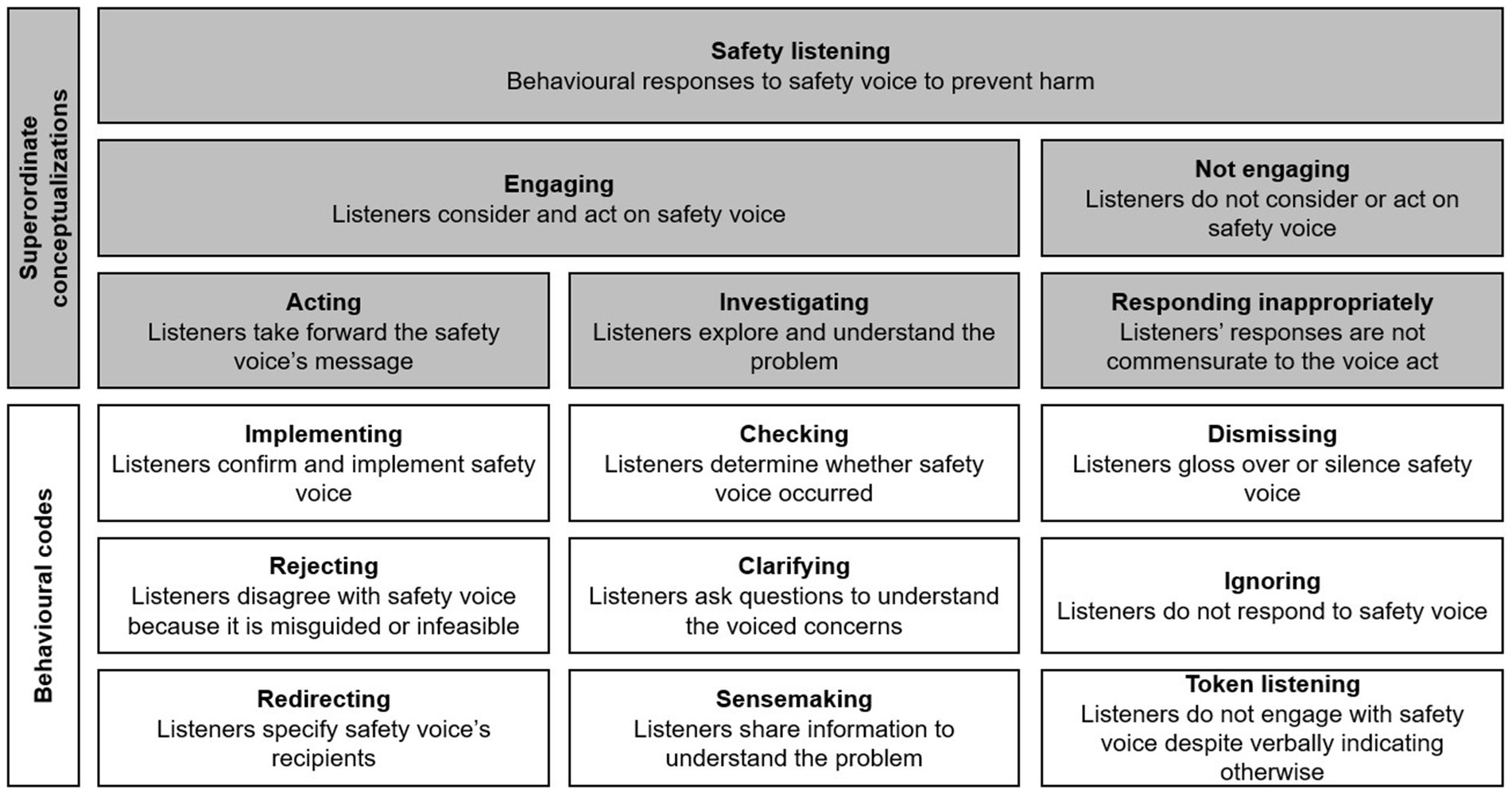
Figure 2. Initial safety listening behavior framework. Adapted from “Safety listening taxonomy.” Pandolfo, Reader, and Gillespie, under CC BY 4.0 (78).
Sometimes individuals initiated additional voice acts in response to non-engagement (e.g., being dismissed). Voicers sometimes escalated their concerns with more urgency (‘escalating safety voice’; see Air China 428 in Table 2), or third parties amplified concerns by reiterating them more directly. For example, Air Canada 759’s cockpit—which had mistakenly aligned to land on a taxiway containing four aircraft—voiced that they saw ‘some lights on the runway’. The ATC assured them that ‘There is no one on 28R [the runway] but you’, failing to realize the problem. United 1 amplified Air Canada 759’s original concern, saying, ‘Where’s this guy going? He’s on the taxiway!’, prompting the ATC to request Air Canada 759 to abort their landing. We therefore added additional voice acts as behaviors following non-engagement with concerns. Pandolfo et al. (78) provide more detail about this analysis.
2.4 Taxonomy iteration
To refine EARS, we undertook an iterative process consisting of applying coding framework prototypes to unseen transcripts, troubleshooting, and adjusting measurement protocols (55). Each iteration combined quantitative (interrater reliability) and qualitative (coder feedback) evaluation of the tool’s performance, aligning with recommendations to use interrater reliability to uncover, investigate, and address areas of dissensus in qualitative coding (56).
We trained three master’s-level research assistants who were involved in transcription to apply EARS version one to flightdeck transcripts. Four coders (i.e., Author 1 and the research assistants) then independently applied EARS to batches of 10 transcripts, starting with incidents occurring in 2024 and working backward. After each batch, we solicited coder feedback—including challenging transcripts and edge cases—and calculated interrater reliability using Python. We measured interrater reliability using Krippendorff’s alpha and Gwet’s ACT1 because they account for zero values and multiple coders, respectively (57). We interpreted the scores as follows: 0.01–0.20 = poor/slight agreement; 0.21–0.40 = fair agreement; 0.41–0.60 = moderate agreement; 0.61–0.80 = substantial agreement; and 0.81–1.00 = excellent agreement (58). Integrating feedback, we revised EARS and repeated the process until saturation [i.e., minimal comments and revisions; (59)], resulting in the final version.
EARS was finalized after four transcript batches (n = 40 transcripts, 2,244 lines, 19,433 words, from 2021 to 2024). Recognizing that some codes overlapped, we reduced the nine safety listening types to six (Figure 3). Specifically, we
(1) Recategorized ‘redirecting’ under ‘implementing’ because this behavior can be considered a form of implementation (i.e., understanding that the message was meant for a specific recipient and directing it to them);
(2) Combined ‘checking’ and ‘clarifying’ into ‘questioning’ because these behaviors involve asking whether someone spoke up and requesting more information about concerns;
(3) Merged ‘dismissing’ and ‘ignoring’ under ‘dismissing’ because these behaviors both can result in silencing voicers;
(4) Renamed ‘sensemaking’ as ‘elaborating’ because these behaviors served to build on the team’s understanding of the unfolding situation;
(5) Changed the category of ‘investigating’ to ‘sensemaking’ to better encompass the codes of ‘questioning’ and ‘elaborating’;
(6) Renamed ‘surface engagement’ as ‘token listening’; and
(7) Renamed ‘rejecting’ as ‘declining’.
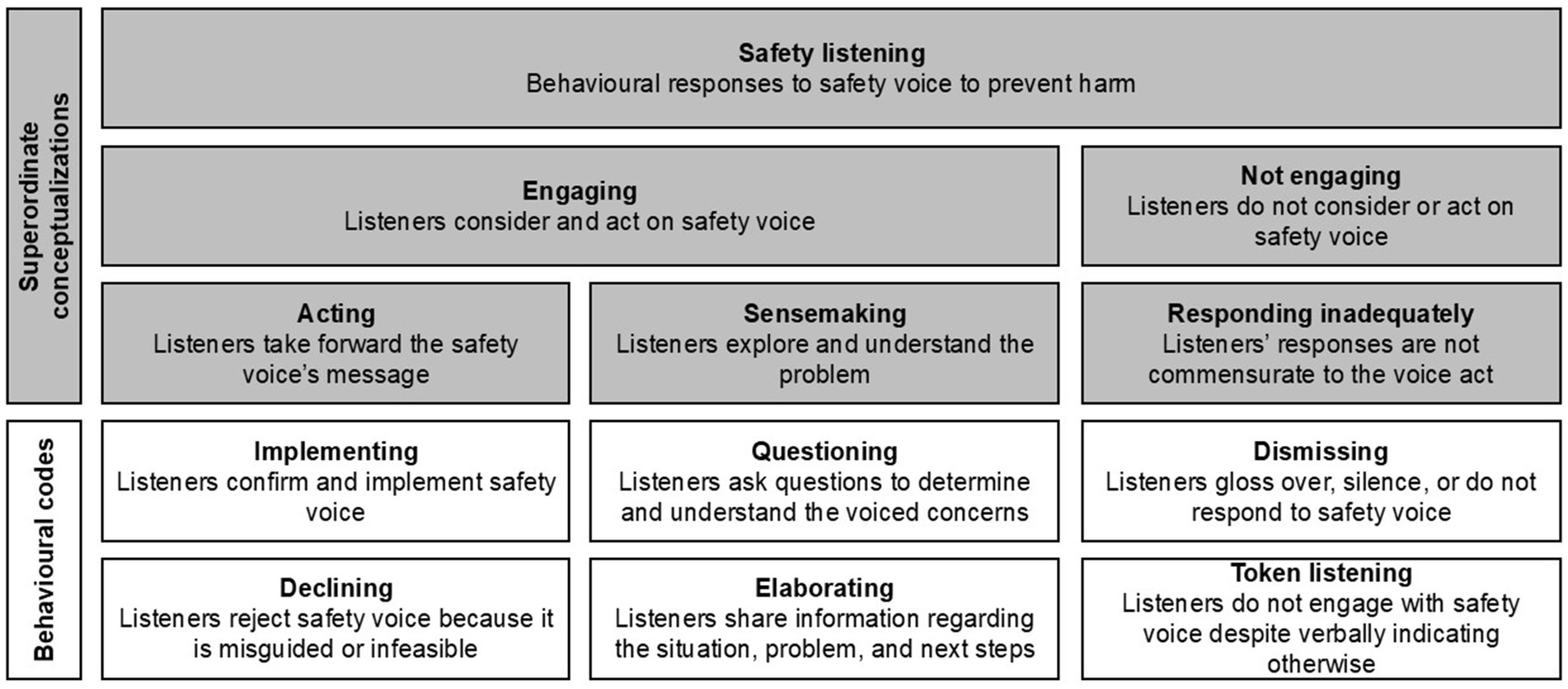
Figure 3. Final safety listening behavior framework. Reproduced from “Safety listening taxonomy.” Pandolfo, Reader, and Gillespie, under CC BY 4.0 (78).
We experimented with coding token listening separately (i.e., not as a type of listening) because identifying this listening form required an understanding of additional conversation turns or the accident itself. Separating token listening instead of classifying it as a listening type did not make a difference, and we kept it as a type of non-engaged listening.
We clarified that coders do not need to code every line between safety voice and the incident because some utterances following safety voice were irrelevant (e.g., the ATC giving routine updates). Likewise, some utterances could be classified under multiple codes, and we allowed coders to do so, but stressed that, where possible, one code should be used.
The final EARS coding framework with examples is presented in Table 7, and the full manual is freely available to download (Supplementary material 1). The last batch of transcripts analyzed in this phase had an overall Krippendorff’s alpha of 0.73 and a Gwet’s ACT1 of 0.80.
2.5 Taxonomy testing
The final version of EARS was tested in three ways. First, we applied EARS to an unseen dataset, using the same three research assistant coders as in the taxonomy iteration. The coders applied the final version to 110 unseen flightdeck transcripts. These transcripts began from the point where taxonomy iteration stopped, and Author 1 and the coders met approximately biweekly to discuss feedback and edge cases. Interrater reliability was calculated as described above. Included incidents occurred between 2016 and 2021, and transcripts consisted of 10,560 lines and 100,062 words. The interrater reliability scores for all codes in these transcripts were a Krippendorff’s alpha of 0.77 and a Gwet’s ACT1 of 0.87. Table 8 provides a code-by-code breakdown.
Second, a psychology master’s-level coder—who was uninvolved in transcription and taxonomy iteration—independently coded 50 transcripts using the final tool. These transcripts were a subset of the 110 and all occurred in 2019 and 2020 (n = 30 and 20, respectively). Before coding, the coder received training which included explaining the final coding framework with examples and coding three transcripts with Author 1. Midway through coding, the coder and Author 1 met to discuss edge cases and coded an additional transcript together. Interrater reliability was calculated as described above. The data consisted of 4,824 lines and 43,936 words. This analysis’ interrater reliability scores for all codes were a Krippendorff’s alpha of 0.76 and a Gwet’s ACT1 of 0.87.
Third, we identified transcript lines where all coders disagreed in the previous two analyses. Using inductive thematic analysis (60), we formed themes at the semantic level summarizing content where the EARS tool resulted in discrepant coding. We found that all coders disagreed 169 times in the first analysis (larger unseen dataset) and 20 times in the second (new coder). Similar to the findings by MacPhail et al. (61), we noted that in most instances where coders had used different codes, the codes were from the same thematic group (e.g., engagement with voice). As illustrated in Table 9, coders had difficulty when communications were ambiguous (e.g., unintelligible utterances), transcript lines contained aspects which conformed to multiple codes (e.g., declining suggestions and asking questions), and/or it was unclear whether listening acts occurred (e.g., confirming one’s attention).
3 Discussion
In this article, we developed, iterated, and tested the EARS tool—a reliable assessment of safety listening behaviors in naturalistic and high-risk conversations. The research aimed to understand and improve responses to safety voice, thereby enhancing safety in risky organizations. Raising and responding to safety concerns are crucial for averting organizational disasters (5, 6), yet to date, there has been no reliable tool for classifying naturalistic behaviors following speaking up. Such a tool is necessary for scholars to empirically examine safety listening behaviors, addressing calls for balancing the use of self-report and behavioral measures (6, 28).
Measuring safety voice and safety listening has conceptual and operational difficulties. Voice and listening are typically measured using self-reports despite both being observable behaviors, likely due to these concepts’ elusiveness and difficulties capturing them naturalistically (5, 6). Moreover, safety listening requires the occurrence of safety voice; there is no listening without speaking up. Thus, developing a safety listening behavioral framework requires a reliable and valid voice typology to identify safety voice acts. Here, we coded safety voice consistent with Noort et al. (36) which conceptualized safety voice behaviors as binary (i.e., voice or silence).
The EARS tool comprises six forms of safety listening behavior and two additional safety voice acts. Its components include response behaviors identified in previous empirical studies [e.g., content is implemented; (12)]; however, rather than positioning effective listening as agreeing with voicers, EARS posits that effective listening engages with voice. As such, it goes against the prevailing assumption in the literature that listening is attitudinal (i.e., individuals did not listen because they did not want to), moving toward a conceptualization of listening as skill based, with the effectiveness of behavior hinging on the context and situation. The engagement behaviors captured by EARS include implementing suggestions, declining misinformed safety voice, questioning voicers, and elaborating on their understanding of the situation. Conversely, non-engagement included dismissing or ignoring voicers, and token listening—where listeners’ verbal responses are inconsistent with their actions.
We also identified two additional safety voice acts that occurred after poor safety listening: escalating and amplifying voice. These additional voice acts illustrate processes through which poor listening may be rectified via clearer and more direct subsequent conversation turns and third parties amplifying initial concerns.
3.1 Theoretical and practical implications
Creating the EARS tool will improve safety listening’s conceptual clarity (40), allow for comparable empirical findings, and reliably analyze safety communication in hitherto neglected large public behavioral datasets [e.g., Flint water crisis emails; see Pandolfo et al. (6) for other possible datasets]. By analyzing pre-incident conversations, we aim to glean insights into their influence on the likelihood of accidents. Ultimately, this tool can be used in organizations to give feedback, analyze incidents, and score simulations. It can also be integrated into various training programs (e.g., crew resource management) and inform policy decisions, thereby contributing to safety standards’ continuous improvement.
EARS can be used to develop interventions and assess listening behaviors pre- and post-intervention (e.g., measuring status quo safety listening in organizations to establish a baseline against which to evaluate this behavior during and after interventions). Like non-technical skills (62), crew resource management (63), and workplace listening (64) programs, listening is a trainable skill. Accordingly, training effective safety listening behaviors may reduce harm in high-risk organizations like aviation. For instance, training programs may teach strategies for clarifying hinted-at concerns, disagreeing with misdirected voice, and addressing multiple voicers delivering conflicting information. The program should incorporate real conversation recordings to help participants assess how others in their roles communicate effectively and how they could concretely improve (65).
Assessing intervention effectiveness may be aided by developing a large language model (LLM) text classifier to identify safety listening behaviors. At present, EARS is a reliable manual coding system. LLM text classifiers can be used to quickly code datasets consisting of thousands of conversation transcripts. Developing classifiers could be done using prompt engineering with LLMs like GPT-4. Researchers should iterate on prompts (e.g., ‘do any lines of transcript engage with a safety concern?’) to instruct the LLM on how to classify the textual data and test its accuracy against manually coded qualitative data. An automated system could run in real-time (i.e., coding listening behaviors during high-risk interactions). The LLM’s generalizability and misclassifications should be assessed to determine the prompt’s validity in reproducing the manual coding framework.
Although EARS was developed in aviation, there are promising opportunities for its application in other contexts. These include assessing co-located teams in other high-reliability organizations, lone workers, and responses to promotive safety voice (Table 10). Likewise, it could be adapted into a standard and valid Likert-type survey to create a scalable, low-cost measurement of individual and team listening behaviors. For instance, as safety voice climate scales exist [(e.g., 66)], a counterpart ‘safety listening climate’ scale could be created. While this survey would risk biases (e.g., self-report) and require cross-industry validation, it would enable benchmarking, soliciting multiple perspectives (e.g., self, peer, supervisor), and linking these perceptions to coded behavior.
3.2 Limitations and future directions
This research has limitations. First, raters had difficulty coding ambiguous transcript lines, specifically those with unclear utterances (e.g., unintelligible parts), content which encompassed multiple codes, and situations where speakers were requesting or confirming attention. In particular, the codes of declining, dismissing, and token listening had notable between-rater frequency differences, possibly due to coinciding with other codes in the same utterance. These codes were also rare (i.e., less than 100 instances for each); raters may have developed conflicting ideas about their inclusion/exclusion because they did not have as much practice or feedback with them. These situations should be considered when applying EARS to other transcripts and datasets.
Second, despite our best efforts to include global transcripts, most (128/150) incidents occurred in American airspace. This skew is likely caused by three factors. First, the United States’ National Transportation Safety Board database had the largest number of publicly available transcripts and incident reports, and most of the VASAviation recordings occurred in America. Second, some countries (e.g., the UK) legally prohibit the public from recording ATC feeds, meaning that their airports have few publicly available recordings (41). Third, some governmental agencies (e.g., Transportation Safety Board of Canada) have policies that exclude flightdeck conversation transcripts from incident reports as they consider these data to be privileged. As flightdeck communication varies by national culture (67), future studies should investigate EARS’ cross-cultural generalizability.
Third, EARS was developed using transcripts of flightdeck conversations. We recognize that pilots, ATCs, and other aviation staff are trained in communication through initiatives like crew resource management. Consequently, individuals in our transcripts may have exhibited more engagement with concerns than those in other contexts. Flightdeck communications are urgent and time-sensitive, with crew members collaborating transparently as a team, while pilots face direct physical risks in the event of a crash. Accordingly, we found the most common codes were implementing, elaborating, and questioning. Conversely, an analysis of speaking-up and responses in the Mid Staffordshire hospital scandal (1,200 died from poor healthcare) found that the commonest response to speaking-up was inaction [i.e., acknowledging a concern but not correcting it; (14)]. EARS would classify the non-responses as non-engagement, specifically ‘dismissing’. With appropriate modifications, we believe that EARS can be generalized to code safety listening in written responses to complaints, in situ observations, and in non-aviation contexts (e.g., surgical teams). Following the suggestions presented in Table 10, future studies should investigate safety listening in other contexts to discern how these factors influence engagement with concerns.
Fourth, piloting an airplane is not entirely verbal; therefore, there may be actions which are not captured in the transcripts. For instance, a solo pilot may silently run through a checklist; however, this action would not be captured on the transcript unless the pilot announced this behavior to the ATC.
Last, EARS assesses safety listening behavior in naturalistic conversations. While we encourage safety listening researchers to assess behavior in naturalistic data, we recognize that this data type cannot assess attitudes, rationales, or felt emotions, which might influence outcomes. Self-report measures are necessary for assessing such intentions and psychological states. Like Barnes et al. (68), we recommend that future research triangulate behavioral and self-report data to develop deeper insights into the relationship between psychological states, communications, and incidents. One possibility within aviation would be for scholars to analyze aviation incidents in the National Transportation Safety Board database, for which there are (1) incident reports, (2) post hoc interview transcripts with relevant parties (e.g., pilots and ATC), and (3) CVR or ATC transcripts.
4 Conclusion
In this article, we developed and tested the Ecological Assessment of Responses to Speaking-up (EARS) tool. This assessment provides a reliable and theoretically grounded framework through which safety listening acts can be identified, learned from, and investigated in relation to speaking-up and incident outcomes. In contrast to the idea that effective listening agrees with voicers, EARS emphasizes the importance of engaging with safety voice. EARS identifies six safety listening behaviors: action (implementing and declining), sensemaking (questioning and elaborating), and non-engagement (dismissing and token listening), and two additional safety voice acts: escalating and amplifying safety voice. We demonstrate that this tool achieved substantial interrater reliability and allows for the assessment of safety listening behaviors in naturalistic, high-risk conversations. EARS can be used to analyze safety listening’s antecedents, its relationship with safety voice and outcomes, and pre- and post-intervention safety communications to improve organizational safety.
Data availability statement
The raw data supporting the conclusions of this article will be made available by the authors, without undue reservation.
Ethics statement
The studies involving humans were approved by London School of Economics (ref: 65889). The studies were conducted in accordance with the local legislation and institutional requirements. Written informed consent for participation was not required from the participants or the participants’ legal guardians/next of kin because the data are publicly available.
Author contributions
AP: Conceptualization, Data curation, Formal analysis, Funding acquisition, Investigation, Methodology, Project administration, Visualization, Writing – original draft. TR: Conceptualization, Funding acquisition, Investigation, Methodology, Project administration, Resources, Supervision, Validation, Writing – review & editing. AG: Conceptualization, Formal analysis, Funding acquisition, Investigation, Methodology, Resources, Software, Supervision, Validation, Writing – review & editing.
Funding
The author(s) declare that financial support was received for the research and/or publication of this article. This work was supported by a London School of Economics PhD studentship and the London School of Economics PhD Data Collection Fund.
Acknowledgments
We would like to thank Carolina Avila-Medina, Kate Baird, and Teresa Xiao for their assistance with coding, and we extend our gratitude to them and Jakob Kiessling for their transcription help. We would also like to thank Hamish Duncan for his help with coding. We would like to thank Alex Goddard for his help with scraping and with interrater reliability calculations. We would also like to acknowledge Harro Ranter and the Aviation Safety Network, Mark Noort, tailstrike.com, the National Transportation Safety Board, and Victor from VASAviation for the transcripts, recordings, and incident reports used in this research. This work was presented at the European Association of Work and Organizational Psychology conference in Prague in May 2025.
Conflict of interest
The authors declare that the research was conducted in the absence of any commercial or financial relationships that could be construed as a potential conflict of interest.
Generative AI statement
The authors declare that no Gen AI was used in the creation of this manuscript.
Any alternative text (alt text) provided alongside figures in this article has been generated by Frontiers with the support of artificial intelligence and reasonable efforts have been made to ensure accuracy, including review by the authors wherever possible. If you identify any issues, please contact us.
Publisher’s note
All claims expressed in this article are solely those of the authors and do not necessarily represent those of their affiliated organizations, or those of the publisher, the editors and the reviewers. Any product that may be evaluated in this article, or claim that may be made by its manufacturer, is not guaranteed or endorsed by the publisher.
Supplementary material
The Supplementary material for this article can be found online at: https://www.frontiersin.org/articles/10.3389/fpubh.2025.1652250/full#supplementary-material
References
1. Edmondson, AC. The fearless organization: Creating psychological safety in the workplace for learning, innovation, and growth John Wiley & Sons (2018).
2. Reader, TW, and O’Connor, P. The Deepwater horizon explosion: non-technical skills, safety culture, and system complexity. J Risk Res. (2014) 17:405–24. doi: 10.1080/13669877.2013.815652 (Accessed July 3, 2025).
3. Robison, W, Boisjoly, R, Hoeker, D, and Young, S. Representation and misrepresentation: Tufte and the Morton Thiokol engineers on the challenger. Engineer Ethics. (2017) 8:121–44. doi: 10.4324/9781315256474-12
4. Flin, R, Reader, TW, and O’Connor, P. Safety at the sharp end: a guide to non-technical skills. 2nd ed, CRC Press. (2025).
5. Noort, MC, Reader, TW, and Gillespie, A. Speaking up to prevent harm: a systematic review of the safety voice literature. Saf Sci. (2019) 117:375–87. doi: 10.1016/j.ssci.2019.04.039
6. Pandolfo, AM, Reader, TW, and Gillespie, A. Safety listening in organizations: an integrated conceptual review. Organ Psychol Rev. (2025) 15:93–124. doi: 10.1177/20413866241245276
7. Fernando, D, and Prasad, A. Sex-based harassment and organizational silencing: how women are led to reluctant acquiescence in academia. Hum Relat. (2019) 72:1565–94. doi: 10.1177/0018726718809164
8. Long, J, Jowsey, T, Garden, A, Henderson, K, and Weller, J. The flip side of speaking up: a new model to facilitate positive responses to speaking up in the operating theatre. Br J Anaesth. (2020) 125:1099–106. doi: 10.1016/j.bja.2020.08.025
9. Park, H, Bjørkelo, B, and Blenkinsopp, J. External whistleblowers’ experiences of workplace bullying by superiors and colleagues. J Bus Ethics. (2020) 161:591–601. doi: 10.1007/s10551-018-3936-9
10. Dietz, AS, Pronovost, PJ, Benson, KN, Mendez-tellez, PA, Dwyer, C, Wyskiel, R, et al. A systematic review of behavioural marker systems in healthcare: what do we know about their attributes, validity and application? BMJ Qual Saf. (2014) 23:1031–9. doi: 10.1136/bmjqs-2013-002457
11. Barlow, M, Watson, B, and Jones, E. Understanding observed receiver strategies in the healthcare speaking up context. Int J Healthcare Simul. (2023):1–12. doi: 10.54531/SUFD5615
12. Lemke, R, Burtscher, MJ, Seelandt, JC, Grande, B, and Kolbe, M. Associations of form and function of speaking up in anaesthesia: a prospective observational study. Br J Anaesth. (2021) 127:971–80. doi: 10.1016/j.bja.2021.08.014
13. Noort, MC, Reader, TW, and Gillespie, A. Safety voice and safety listening during aviation accidents: cockpit voice recordings reveal that speaking-up to power is not enough. Saf Sci. (2021) 139:105260. doi: 10.1016/j.ssci.2021.105260
14. Reader, TW. Stakeholder safety communication: patient and family reports on safety risks in hospitals. J Risk Res. (2022) 25:807–24. doi: 10.1080/13669877.2022.2061036
15. Westrum, R. The study of information flow: a personal journey. Saf Sci. (2014) 67:58–63. doi: 10.1016/j.ssci.2014.01.009
16. O’Donovan, R, and McAuliffe, E. A systematic review exploring the content and outcomes of interventions to improve psychological safety, speaking up and voice behaviour. BMC Health Serv Res. (2020) 20:1–11. doi: 10.1108/10650759710189443
17. Bazzoli, A, and Curcuruto, M. Safety leadership and safety voices: exploring the mediation role of proactive motivations. J Risk Res. (2021) 24:1368–87. doi: 10.1080/13669877.2020.1863846
18. Teo, H, and Caspersz, D. Dissenting discourse: exploring alternatives to the whistleblowing/silence dichotomy. J Bus Ethics. (2011) 104:237–49. doi: 10.1007/s10551-011-0906-x
19. Noort, MC, Reader, TW, and Gillespie, A. The sounds of safety silence: interventions and temporal patterns unmute unique safety voice content in speech. Saf Sci. (2021) 140:105289. doi: 10.1016/j.ssci.2021.105289
20. Rehg, MT, Miceli, MP, Near, JP, and Van Scotter, JR. Antecedents and outcomes of retaliation against whistleblowers: gender differences and power relationships. Organ Sci. (2008) 19:221–40. doi: 10.1287/orsc.1070.0310
21. Cleary, SR, and Duke, M. Clinical governance breakdown: Australian cases of wilful blindness and whistleblowing. Nurs Ethics. (2019) 26:1039–49. doi: 10.1177/0969733017731917
22. Peirce, E, Smolinski, CA, and Rosen, B. Why sexual harassment complaints fall on deaf ears. Acad Manage Exec. (1998) 12:41–54. doi: 10.5465/ame.1998.1109049
23. Martin, B, and Rifkin, W. The dynamics of employee dissent: whistleblowers and organizational jiu-jitsu. Public Organ Rev. (2004) 4:221–38. doi: 10.1023/b:porj.0000036869.45076.39
24. Roulet, TJ, and Pichler, R. Blame game theory: scapegoating, whistleblowing and discursive struggles following accusations of organizational misconduct. Organization Theory. (2020) 1:5192. doi: 10.1177/2631787720975192
25. Chiaburu, DS, Farh, C, and Van Dyne, L. Supervisory epistemic, ideological, and existential responses to voice: a motivated cognition approach In: Burke RJ and Cooper CL, editors. Voice and whistleblowing in organizations : Edward Elgar Publishing (2013). p. 224–253.
26. Cros, S, Tiberghien, B, and Bertolucci, M. Senselistening and the reorganisation of collective action during crises management: the Notre-dame de Paris fire. Organ Stud. (2025) 46:941–65. doi: 10.1177/01708406251323723
27. Andersen, JP. Applied research is the path to legitimacy in psychological science. Nat Rev Psychol. (2025) 4:1–2. doi: 10.1038/s44159-024-00388-9
28. Baumeister, RF, Vohs, KD, and Funder, DC. Psychology as the science of self-reports and finger movements: whatever happened to actual behavior? Perspect Psychol Sci. (2007) 2:396–403. doi: 10.1111/j.1745-6916.2007.00051.x
29. Diener, E, Northcott, R, Zyphur, MJ, and West, SG. Beyond experiments. Perspect Psychol Sci. (2022) 17:1101–19. doi: 10.1177/17456916211037670
30. Ross, L. The intuitive psychologist and his shortcomings: distortions in the attribution process In: L Berkowitz, editor. Advances in experimental social psychology. 10th ed: Academic Press (1977). p. 173–220.
31. van de Mortel, T. Faking it: social desirability response bias in self-report research. Aust J Adv Nurs. (2008) 25:40–8.
32. Yeomans, M., Boland, F. K., Collins, H. K., Abi-Esber, N., and Wood Brooks, A. A practical guide to conversation research: how to study what people say to each other. The journal is Advances in Methods and Practices in Psychological Science. (2023) 6:1–38. doi: 10.1177/25152459231183919
33. Bodie, GD, Jones, SM, Vickery, AJ, Hatcher, L, and Cannava, K. Examining the construct validity of enacted support: a multitrait–multimethod analysis of three perspectives for judging immediacy and listening behaviors. Commun Monogr. (2014) 81:495–523. doi: 10.1080/03637751.2014.957223
34. Collins, HK. When listening is spoken. Curr Opin Psychol. (2022) 47:101402. doi: 10.1016/j.copsyc.2022.101402
35. Waller, MJ, and Uitdewilligen, S. Talking to the room: collective sensemaking during crisis situations In: Roe RA, Waller MJ, and Clegg SR, editors. Time in organizational research (London: Routledge) (2008). 208–225.
36. Noort, MC, Reader, TW, and Gillespie, A. Cockpit voice recorder transcript data: capturing safety voice and safety listening during historic aviation accidents. Data Brief. (2021) 39:107602. doi: 10.1016/j.dib.2021.107602
37. Mehl, MR. The electronically activated recorder (EAR): a method for the naturalistic observation of daily social behavior. Curr Dir Psychol Sci. (2017) 26:184–90. doi: 10.1177/0963721416680611
38. Moberly, R. ‘To persons or organizations that may be able to effect action’: whistleblowing recipients In: Brown AJ, Lewis D, Moberly RE, and Vandekerckhove W, editors. International handbook on whistleblowing research, vol. 2014. Edward Elgar Publishing. (2014). 273–97.
39. Ren, Z, and Schaumberg, R. Disagreement is a short-hand for poor listening: why speakers evaluate others’ listening quality based on whether others agree with them. SSRN Electron J. (2023):1–38. doi: 10.2139/ssrn.4394203
40. Bringmann, LF, Elmer, T, and Eronen, MI. Back to basics: the importance of conceptual clarification in psychological science. Curr Dir Psychol Sci. (2022) 31:340–6. doi: 10.1177/09637214221096485
41. LiveATC.net. (2024). Available online at: liveatc.net (Accessed July 3, 2025).
42. Perkins, K, Ghosh, S, and Hall, C. Interpersonal skills in a sociotechnical system: a training gap in flight decks. J Aviat Aerospace Educ Res. (2024) 33:1–24. doi: 10.58940/2329-258x.2022
43. Perkins, K, Ghosh, S, Vera, J, Aragon, C, and Hyland, A. The persistence of safety silence: how flight deck microcultures influence the efficacy of crew resource management. Int J Aviat Aeronaut Aerosp. (2022) 9:1–14. doi: 10.15394/ijaaa.2022.1728
44. Power, SA, Zittoun, T, Akkerman, S, Wagoner, B, Cabra, M, Cornish, F, et al. Social psychology of and for world-making. Personal Soc Psychol Rev. (2023) 27:378–92. doi: 10.1177/10888683221145756
45. Ceken, S. Non-technical skills proficiency in aviation pilots: a systematic review. Int J Aviat Aeronaut Aerosp. (2024) 11:1–29.
46. Fontana, PC, Cohen, SD, and Wolvin, AD. Understanding listening competency: a systematic review of research scales. Int J Listen. (2015) 29:148–76. doi: 10.1080/10904018.2015.1015226
47. Weick, KE. Enacted sensemaking in crisis situations. J Manage Stud. (1988) 25:305–17. doi: 10.1111/j.1467-6486.1988.tb00039.x
48. Weick, KE. The vulnerable system: an analysis of the Tenerife air disaster. J Manage. (1990) 16:571–93. doi: 10.1177/014920639001600304
49. Gillespie, A. Disruption, self-presentation, and defensive tactics at the threshold of learning. Rev Gen Psychol. (2020) 24:382–96. doi: 10.1177/1089268020914258
50. Satterstrom, P, Kerrissey, M, and DiBenigno, J. The voice cultivation process: how team members can help upward voice live on to implementation. Adm Sci Q. (2021) 66:380–425. doi: 10.1177/0001839220962795
51. Gillespie, A., Glaveanu, V., and de Saint Laurent, C. Pragmatism and methodology: doing research that matters with mixed methods. Cambridge, UK: Cambridge University Press. (2024).
52. Hsieh, HF, and Shannon, SE. Three approaches to qualitative content analysis. Qual Health Res. (2005) 15:1277–88. doi: 10.1177/1049732305276687
53. Shepherd, D, and Sutcliffe, K. Inductive top-down theorizing: a source of new theories of organization. Acad Manag Rev. (2011) 36:361–80. doi: 10.5465/amr.2009.0157
54. Sætre, AS, and Van De Ven, A. Generating theory by abduction. Acad Manag Rev. (2021) 46:684–701. doi: 10.5465/amr.2019.0233
55. Goddard, A, and Gillespie, A. The repeated adjustment of measurement protocols (RAMP) method for developing high-validity text classifiers. Psychol Methods. (2025). doi: 10.1037/met0000787
56. Cole, R. Inter-rater reliability methods in qualitative case study research. Sociol Methods Res. (2024) 53:1944–75. doi: 10.1177/00491241231156971
57. Feng, GC. Intercoder reliability indices: disuse, misuse, and abuse. Qual Quant. (2014) 48:1803–15. doi: 10.1007/s11135-013-9956-8
58. Gwet, K. L. (2014). Handbook of inter-rater reliability: the definitive guide to measuring the extent of agreement among raters.
59. Saunders, B, Sim, J, Kingstone, T, Baker, S, Waterfield, J, Bartlam, B, et al. Saturation in qualitative research: exploring its conceptualization and operationalization. Qual Quant. (2018) 52:1893–907. doi: 10.1007/s11135-017-0574-8
60. Braun, V, and Clarke, V. Using thematic analysis in psychology. Qual Res Psychol. (2006) 3:77–101. doi: 10.1191/1478088706qp063oa
61. MacPhail, C, Khoza, N, Abler, L, and Ranganathan, M. Process guidelines for establishing intercoder reliability in qualitative studies. Qual Res. (2016) 16:198–212. doi: 10.1177/1468794115577012
62. Fletcher, G, Flin, R, McGeorge, P, Glavin, R, Maran, N, and Patey, R. Rating non-technical skills: developing a behavioural marker system for use in anaesthesia. Cogn Tech Work. (2004) 6:165–71. doi: 10.1007/s10111-004-0158-y
63. Kanki, BG, Anca, J, and Chidester, TR. Crew resource management. 3rd ed. London: Academic Press. (2019).
64. Itzchakov, G, and Kluger, AN. Can holding a stick improve listening at work? The effect of listening circles on employees’ emotions and cognitions. Eur J Work Organ Psychol. (2017) 26:663–76. doi: 10.1080/1359432X.2017.1351429
65. Stokoe, E. The (in)authenticity of simulated talk: comparing role-played and actual interaction and the implications for communication training. Res Lang Soc Interact. (2013) 46:165–85. doi: 10.1080/08351813.2013.780341
66. Mathisen, GE, and Tjora, T. Safety voice climate: a psychometric evaluation and validation. J Saf Res. (2023) 86:174–84. doi: 10.1016/j.jsr.2023.05.008
67. Harris, D, and Li, W. Error on the flight deck: interfaces, organizations, and culture In: Boy GA, editor. The handbook of human-machine interaction. London: CRC Press. (2011). 399–415.
68. Barnes, CM, Dang, CT, Leavitt, K, Guarana, CL, and Uhlmann, EL. Archival data in micro-organizational research: a toolkit for moving to a broader set of topics. J Manage. (2018) 44:1453–78. doi: 10.1177/0149206315604188
69. Aviation Safety Network (2024) ATC transcript south African DC-4-30 JUN 1962. Available online at: https://mail.aviation-safety.net/investigation/transcripts/atc_sadc-4.php
70. Department of Defense. (n.d.). Case study: the Johnson & Johnson Tylenol Crisis. Crisis communication strategies. Available online at: https://www.ou.edu/deptcomm/dodjcc/groups/02C2/Johnson%20&%20Johnson.htm (Accessed July 3, 2025).
71. National Transportation Safety Board (2010) Aircraft accident report – US Airways flight 1549. Accident report, November, 213
72. Newby, G. (2017) Why no-one heard the Grenfell blogger’s warnings. BBC news. Available online at: https://www.bbc.co.uk/news/stories-42072477 (Accessed July 3, 2025).
73. BBC News (2018) Hawaii missile alert: false alarm sparks panic in US state. BBC news. Available online at: https://www.bbc.co.uk/news/world-us-canada-42677604 (Accessed July 3, 2025).
74. National Transportation Safety Board (2024) Runway incursion and rejected takeoff American airlines flight 106 Boeing 777-200, N754AN, and Delta air lines flight 1943 Boeing 737-900, N914DU
75. Detert, JR, and Treviño, LK. Speaking up to higher-ups: how supervisors and skip-level leaders influence employee voice. Organ Sci. (2014) 21:249–70. doi: 10.1287/orsc.1080.0405
76. Richmond, JG, and Burgess, N. Prosocial voice in the hierarchy of healthcare professionals: the role of emotions after harmful patient safety incidents. J Health Organ Manag. (2023) 37:327–42. doi: 10.1108/JHOM-01-2022-0027
77. International Civil Aviation Organization. New guidelines for aviation English training programmes. (2009). Available at: http://trid.trb.org/view.aspx?id=981555
Keywords: safety listening, safety voice, coding framework, safety communication, coding tool, behavioural marker system
Citation: Pandolfo AM, Reader TW and Gillespie A (2025) The Ecological Assessment of Responses to Speaking-up tool—development and reliability testing of a method for coding safety listening behavior in naturalistic conversations. Front. Public Health. 13:1652250. doi: 10.3389/fpubh.2025.1652250
Edited by:
Federica Biassoni, Catholic University of the Sacred Heart, ItalyReviewed by:
Gro Ellen Mathisen, University of Stavanger, NorwayMatteo Curcuruto, Leeds Beckett University, United Kingdom
Copyright © 2025 Pandolfo, Reader and Gillespie. This is an open-access article distributed under the terms of the Creative Commons Attribution License (CC BY). The use, distribution or reproduction in other forums is permitted, provided the original author(s) and the copyright owner(s) are credited and that the original publication in this journal is cited, in accordance with accepted academic practice. No use, distribution or reproduction is permitted which does not comply with these terms.
*Correspondence: Alyssa M. Pandolfo, YS5wYW5kb2xmb0Bsc2UuYWMudWs=
 Alyssa M. Pandolfo
Alyssa M. Pandolfo Tom W. Reader
Tom W. Reader Alex Gillespie
Alex Gillespie